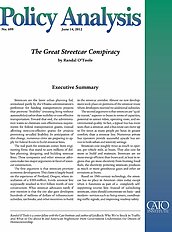Streetcars are the latest urban planning fad, stimulated partly by the Obama administration’s preference for funding transportation projects that promote “livability” (meaning living without automobiles) rather than mobility or cost-effective transportation. Toward that end, the administration wants to eliminate cost-effectiveness requirements for federal transportation grants, instead allowing non-cost-effective grants for projects promoting so-called livability. In anticipation of this change, numerous cities are preparing to apply for federal funds to build streetcar lines.
The real push for streetcars comes from engineering firms that stand to earn millions of dollars planning, designing, and building streetcar lines. These companies and other streetcar advocates make two major arguments in favor of streetcar construction. The first argument is that streetcars promote economic development. This claim is largely based on the experience of Portland, Oregon, where installation of a $103-million, 4‑mile streetcar line supposedly resulted in $3.5 billion worth of new construction.
What streetcar advocates rarely if ever mention is that the city also gave developers hundreds of millions of dollars of infrastructure subsidies, tax breaks, and other incentives to build in the streetcar corridor. Almost no new development took place on portions of the streetcar route where developers received no additional subsidies.
The second argument is that streetcars are “quality transit,” superior to buses in terms of capacities, potential to attract riders, operating costs, and environmental quality. In fact, a typical bus has more seats than a streetcar, and a bus route can move up to five times as many people per hour, in greater comfort, than a streetcar line. Numerous private bus operators provide successful upscale bus service in both urban and intercity settings.
Streetcars cost roughly twice as much to operate, per vehicle mile, as buses. They also cost far more to build and maintain. Streetcars are no more energy efficient than buses and, at least in regions that get most electricity from burning fossil fuels, the electricity powering streetcars produces as much or more greenhouse gases and other air emissions as buses.
Based on 19th-century technology, the streetcar has no place in American cities today except when it functions as part of a completely selfsupporting tourist line. Instead of subsidizing streetcars, cities should concentrate on basic — and modern — services such as fixing streets, coordinating traffic signals, and improving roadway safety.

This work is licensed under a Creative Commons Attribution-NonCommercial-ShareAlike 4.0 International License.

